Business Growth Strategies: A Report on Social Enterprise UK Planning
VerifiedAdded on 2022/12/28
|16
|4789
|73
Report
AI Summary
This report provides a comprehensive analysis of Social Enterprise UK's growth strategy. It begins with an introduction to planning and its importance, followed by an examination of key considerations for evaluating business opportunities, including competitive advantages and PESTEL analysis. The report then utilizes the Ansoff Growth Matrix to evaluate different growth strategies like market penetration, product development, market development, and diversification. Furthermore, it explores various funding sources available to the business, such as angel investors and venture capital. A detailed business plan is presented, along with a discussion of potential exit or succession options. The report concludes with a summary of findings and a list of references, offering valuable insights into the growth and development of Social Enterprise UK.

Planning for growth
Paraphrase This Document
Need a fresh take? Get an instant paraphrase of this document with our AI Paraphraser

Table of Contents
INTRODUCTION...........................................................................................................................3
TASK 1............................................................................................................................................3
P1. Key consideration to evaluate business opportunity and growth:.........................................3
P2. Evaluation of Opportunity by Ansoff Growth Matrix:..........................................................5
TASK 2............................................................................................................................................7
P3. Sources of funds available for business:................................................................................7
TASK 3............................................................................................................................................8
P4. Business plan:........................................................................................................................8
TASK 4..........................................................................................................................................12
P5. Exit or Succession Option for the Business:........................................................................12
CONCLUSION..............................................................................................................................13
REFRENCE...................................................................................................................................15
INTRODUCTION...........................................................................................................................3
TASK 1............................................................................................................................................3
P1. Key consideration to evaluate business opportunity and growth:.........................................3
P2. Evaluation of Opportunity by Ansoff Growth Matrix:..........................................................5
TASK 2............................................................................................................................................7
P3. Sources of funds available for business:................................................................................7
TASK 3............................................................................................................................................8
P4. Business plan:........................................................................................................................8
TASK 4..........................................................................................................................................12
P5. Exit or Succession Option for the Business:........................................................................12
CONCLUSION..............................................................................................................................13
REFRENCE...................................................................................................................................15
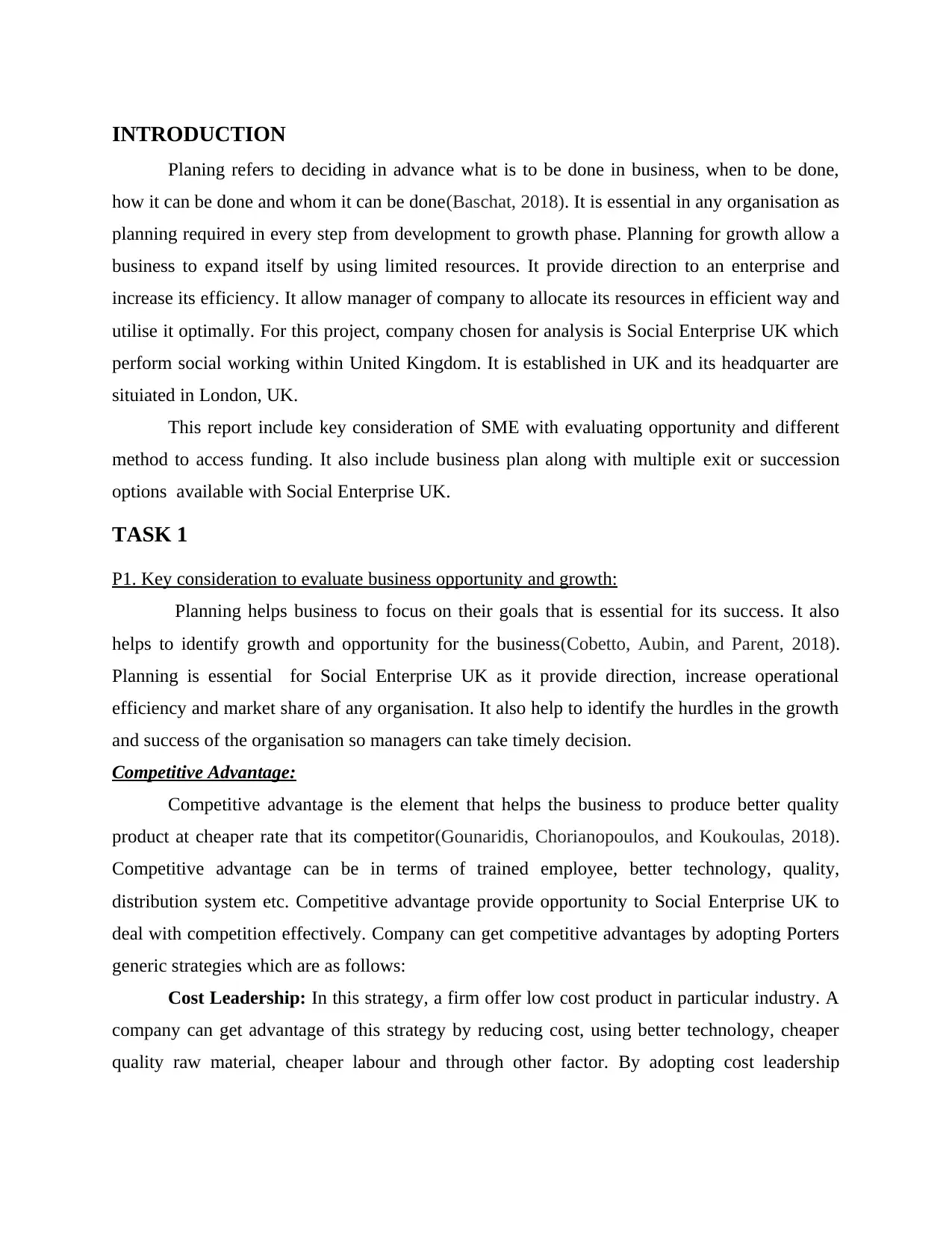
INTRODUCTION
Planing refers to deciding in advance what is to be done in business, when to be done,
how it can be done and whom it can be done(Baschat, 2018). It is essential in any organisation as
planning required in every step from development to growth phase. Planning for growth allow a
business to expand itself by using limited resources. It provide direction to an enterprise and
increase its efficiency. It allow manager of company to allocate its resources in efficient way and
utilise it optimally. For this project, company chosen for analysis is Social Enterprise UK which
perform social working within United Kingdom. It is established in UK and its headquarter are
situiated in London, UK.
This report include key consideration of SME with evaluating opportunity and different
method to access funding. It also include business plan along with multiple exit or succession
options available with Social Enterprise UK.
TASK 1
P1. Key consideration to evaluate business opportunity and growth:
Planning helps business to focus on their goals that is essential for its success. It also
helps to identify growth and opportunity for the business(Cobetto, Aubin, and Parent, 2018).
Planning is essential for Social Enterprise UK as it provide direction, increase operational
efficiency and market share of any organisation. It also help to identify the hurdles in the growth
and success of the organisation so managers can take timely decision.
Competitive Advantage:
Competitive advantage is the element that helps the business to produce better quality
product at cheaper rate that its competitor(Gounaridis, Chorianopoulos, and Koukoulas, 2018).
Competitive advantage can be in terms of trained employee, better technology, quality,
distribution system etc. Competitive advantage provide opportunity to Social Enterprise UK to
deal with competition effectively. Company can get competitive advantages by adopting Porters
generic strategies which are as follows:
Cost Leadership: In this strategy, a firm offer low cost product in particular industry. A
company can get advantage of this strategy by reducing cost, using better technology, cheaper
quality raw material, cheaper labour and through other factor. By adopting cost leadership
Planing refers to deciding in advance what is to be done in business, when to be done,
how it can be done and whom it can be done(Baschat, 2018). It is essential in any organisation as
planning required in every step from development to growth phase. Planning for growth allow a
business to expand itself by using limited resources. It provide direction to an enterprise and
increase its efficiency. It allow manager of company to allocate its resources in efficient way and
utilise it optimally. For this project, company chosen for analysis is Social Enterprise UK which
perform social working within United Kingdom. It is established in UK and its headquarter are
situiated in London, UK.
This report include key consideration of SME with evaluating opportunity and different
method to access funding. It also include business plan along with multiple exit or succession
options available with Social Enterprise UK.
TASK 1
P1. Key consideration to evaluate business opportunity and growth:
Planning helps business to focus on their goals that is essential for its success. It also
helps to identify growth and opportunity for the business(Cobetto, Aubin, and Parent, 2018).
Planning is essential for Social Enterprise UK as it provide direction, increase operational
efficiency and market share of any organisation. It also help to identify the hurdles in the growth
and success of the organisation so managers can take timely decision.
Competitive Advantage:
Competitive advantage is the element that helps the business to produce better quality
product at cheaper rate that its competitor(Gounaridis, Chorianopoulos, and Koukoulas, 2018).
Competitive advantage can be in terms of trained employee, better technology, quality,
distribution system etc. Competitive advantage provide opportunity to Social Enterprise UK to
deal with competition effectively. Company can get competitive advantages by adopting Porters
generic strategies which are as follows:
Cost Leadership: In this strategy, a firm offer low cost product in particular industry. A
company can get advantage of this strategy by reducing cost, using better technology, cheaper
quality raw material, cheaper labour and through other factor. By adopting cost leadership
⊘ This is a preview!⊘
Do you want full access?
Subscribe today to unlock all pages.

Trusted by 1+ million students worldwide
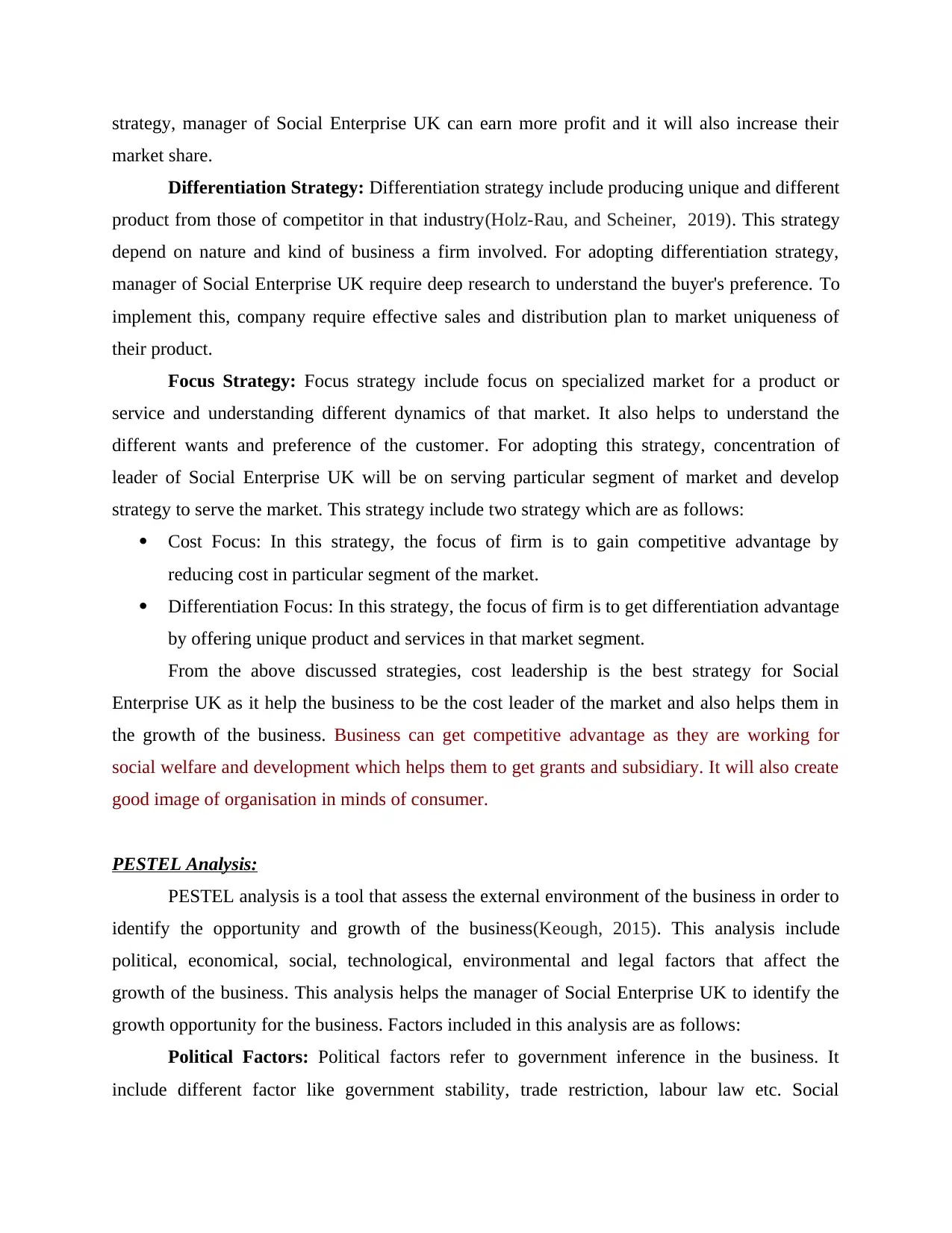
strategy, manager of Social Enterprise UK can earn more profit and it will also increase their
market share.
Differentiation Strategy: Differentiation strategy include producing unique and different
product from those of competitor in that industry(Holz-Rau, and Scheiner, 2019). This strategy
depend on nature and kind of business a firm involved. For adopting differentiation strategy,
manager of Social Enterprise UK require deep research to understand the buyer's preference. To
implement this, company require effective sales and distribution plan to market uniqueness of
their product.
Focus Strategy: Focus strategy include focus on specialized market for a product or
service and understanding different dynamics of that market. It also helps to understand the
different wants and preference of the customer. For adopting this strategy, concentration of
leader of Social Enterprise UK will be on serving particular segment of market and develop
strategy to serve the market. This strategy include two strategy which are as follows:
Cost Focus: In this strategy, the focus of firm is to gain competitive advantage by
reducing cost in particular segment of the market.
Differentiation Focus: In this strategy, the focus of firm is to get differentiation advantage
by offering unique product and services in that market segment.
From the above discussed strategies, cost leadership is the best strategy for Social
Enterprise UK as it help the business to be the cost leader of the market and also helps them in
the growth of the business. Business can get competitive advantage as they are working for
social welfare and development which helps them to get grants and subsidiary. It will also create
good image of organisation in minds of consumer.
PESTEL Analysis:
PESTEL analysis is a tool that assess the external environment of the business in order to
identify the opportunity and growth of the business(Keough, 2015). This analysis include
political, economical, social, technological, environmental and legal factors that affect the
growth of the business. This analysis helps the manager of Social Enterprise UK to identify the
growth opportunity for the business. Factors included in this analysis are as follows:
Political Factors: Political factors refer to government inference in the business. It
include different factor like government stability, trade restriction, labour law etc. Social
market share.
Differentiation Strategy: Differentiation strategy include producing unique and different
product from those of competitor in that industry(Holz-Rau, and Scheiner, 2019). This strategy
depend on nature and kind of business a firm involved. For adopting differentiation strategy,
manager of Social Enterprise UK require deep research to understand the buyer's preference. To
implement this, company require effective sales and distribution plan to market uniqueness of
their product.
Focus Strategy: Focus strategy include focus on specialized market for a product or
service and understanding different dynamics of that market. It also helps to understand the
different wants and preference of the customer. For adopting this strategy, concentration of
leader of Social Enterprise UK will be on serving particular segment of market and develop
strategy to serve the market. This strategy include two strategy which are as follows:
Cost Focus: In this strategy, the focus of firm is to gain competitive advantage by
reducing cost in particular segment of the market.
Differentiation Focus: In this strategy, the focus of firm is to get differentiation advantage
by offering unique product and services in that market segment.
From the above discussed strategies, cost leadership is the best strategy for Social
Enterprise UK as it help the business to be the cost leader of the market and also helps them in
the growth of the business. Business can get competitive advantage as they are working for
social welfare and development which helps them to get grants and subsidiary. It will also create
good image of organisation in minds of consumer.
PESTEL Analysis:
PESTEL analysis is a tool that assess the external environment of the business in order to
identify the opportunity and growth of the business(Keough, 2015). This analysis include
political, economical, social, technological, environmental and legal factors that affect the
growth of the business. This analysis helps the manager of Social Enterprise UK to identify the
growth opportunity for the business. Factors included in this analysis are as follows:
Political Factors: Political factors refer to government inference in the business. It
include different factor like government stability, trade restriction, labour law etc. Social
Paraphrase This Document
Need a fresh take? Get an instant paraphrase of this document with our AI Paraphraser
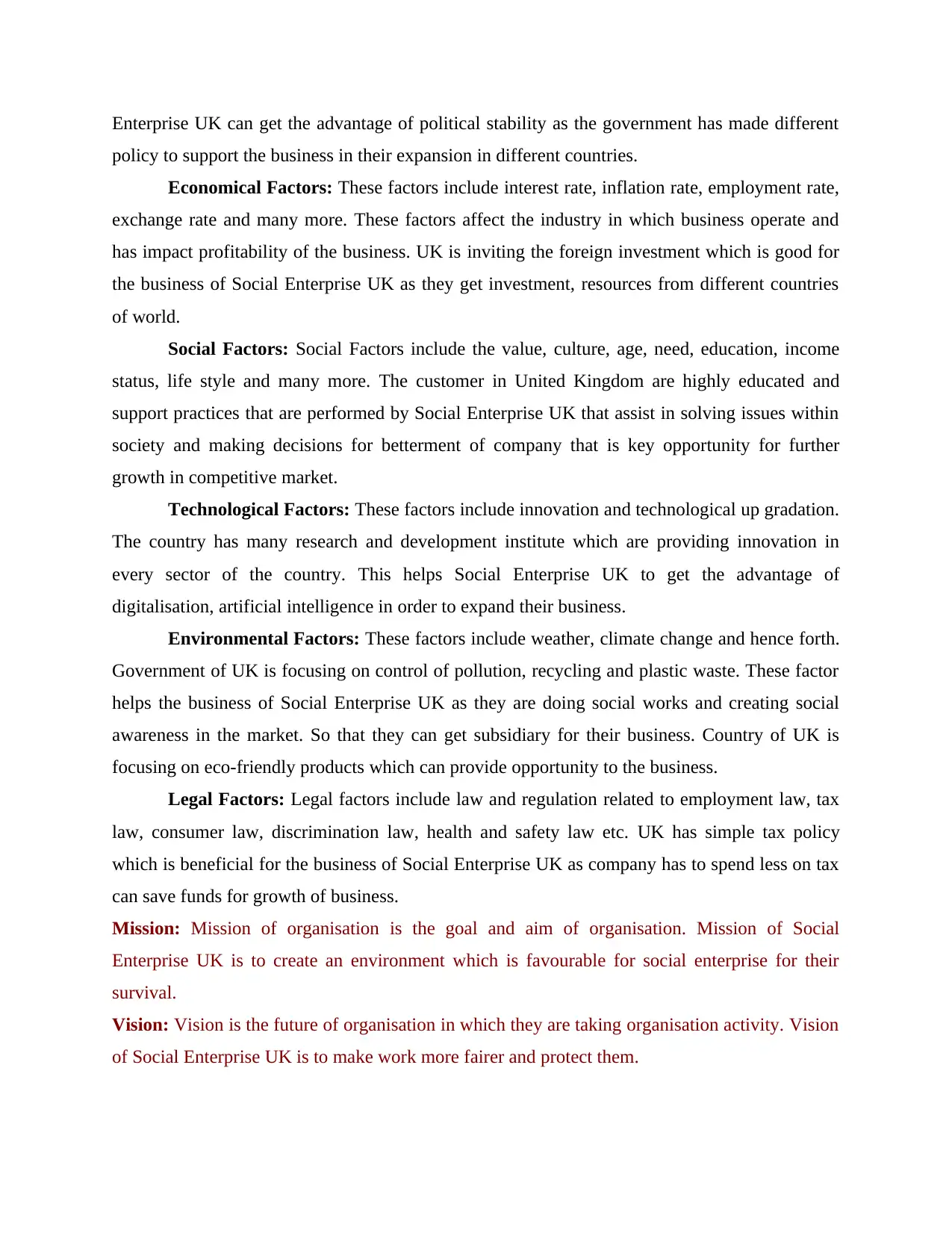
Enterprise UK can get the advantage of political stability as the government has made different
policy to support the business in their expansion in different countries.
Economical Factors: These factors include interest rate, inflation rate, employment rate,
exchange rate and many more. These factors affect the industry in which business operate and
has impact profitability of the business. UK is inviting the foreign investment which is good for
the business of Social Enterprise UK as they get investment, resources from different countries
of world.
Social Factors: Social Factors include the value, culture, age, need, education, income
status, life style and many more. The customer in United Kingdom are highly educated and
support practices that are performed by Social Enterprise UK that assist in solving issues within
society and making decisions for betterment of company that is key opportunity for further
growth in competitive market.
Technological Factors: These factors include innovation and technological up gradation.
The country has many research and development institute which are providing innovation in
every sector of the country. This helps Social Enterprise UK to get the advantage of
digitalisation, artificial intelligence in order to expand their business.
Environmental Factors: These factors include weather, climate change and hence forth.
Government of UK is focusing on control of pollution, recycling and plastic waste. These factor
helps the business of Social Enterprise UK as they are doing social works and creating social
awareness in the market. So that they can get subsidiary for their business. Country of UK is
focusing on eco-friendly products which can provide opportunity to the business.
Legal Factors: Legal factors include law and regulation related to employment law, tax
law, consumer law, discrimination law, health and safety law etc. UK has simple tax policy
which is beneficial for the business of Social Enterprise UK as company has to spend less on tax
can save funds for growth of business.
Mission: Mission of organisation is the goal and aim of organisation. Mission of Social
Enterprise UK is to create an environment which is favourable for social enterprise for their
survival.
Vision: Vision is the future of organisation in which they are taking organisation activity. Vision
of Social Enterprise UK is to make work more fairer and protect them.
policy to support the business in their expansion in different countries.
Economical Factors: These factors include interest rate, inflation rate, employment rate,
exchange rate and many more. These factors affect the industry in which business operate and
has impact profitability of the business. UK is inviting the foreign investment which is good for
the business of Social Enterprise UK as they get investment, resources from different countries
of world.
Social Factors: Social Factors include the value, culture, age, need, education, income
status, life style and many more. The customer in United Kingdom are highly educated and
support practices that are performed by Social Enterprise UK that assist in solving issues within
society and making decisions for betterment of company that is key opportunity for further
growth in competitive market.
Technological Factors: These factors include innovation and technological up gradation.
The country has many research and development institute which are providing innovation in
every sector of the country. This helps Social Enterprise UK to get the advantage of
digitalisation, artificial intelligence in order to expand their business.
Environmental Factors: These factors include weather, climate change and hence forth.
Government of UK is focusing on control of pollution, recycling and plastic waste. These factor
helps the business of Social Enterprise UK as they are doing social works and creating social
awareness in the market. So that they can get subsidiary for their business. Country of UK is
focusing on eco-friendly products which can provide opportunity to the business.
Legal Factors: Legal factors include law and regulation related to employment law, tax
law, consumer law, discrimination law, health and safety law etc. UK has simple tax policy
which is beneficial for the business of Social Enterprise UK as company has to spend less on tax
can save funds for growth of business.
Mission: Mission of organisation is the goal and aim of organisation. Mission of Social
Enterprise UK is to create an environment which is favourable for social enterprise for their
survival.
Vision: Vision is the future of organisation in which they are taking organisation activity. Vision
of Social Enterprise UK is to make work more fairer and protect them.
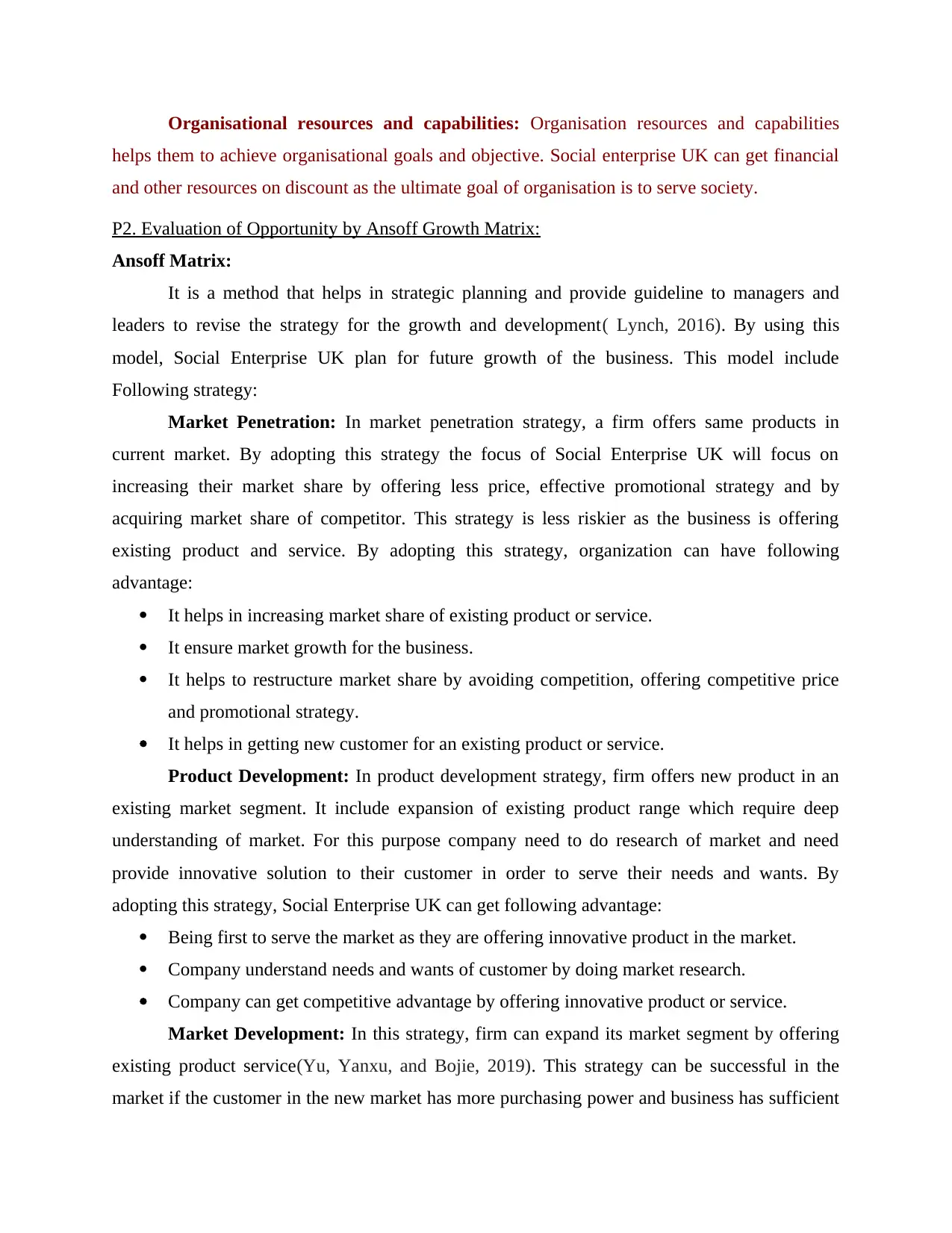
Organisational resources and capabilities: Organisation resources and capabilities
helps them to achieve organisational goals and objective. Social enterprise UK can get financial
and other resources on discount as the ultimate goal of organisation is to serve society.
P2. Evaluation of Opportunity by Ansoff Growth Matrix:
Ansoff Matrix:
It is a method that helps in strategic planning and provide guideline to managers and
leaders to revise the strategy for the growth and development( Lynch, 2016). By using this
model, Social Enterprise UK plan for future growth of the business. This model include
Following strategy:
Market Penetration: In market penetration strategy, a firm offers same products in
current market. By adopting this strategy the focus of Social Enterprise UK will focus on
increasing their market share by offering less price, effective promotional strategy and by
acquiring market share of competitor. This strategy is less riskier as the business is offering
existing product and service. By adopting this strategy, organization can have following
advantage:
It helps in increasing market share of existing product or service.
It ensure market growth for the business.
It helps to restructure market share by avoiding competition, offering competitive price
and promotional strategy.
It helps in getting new customer for an existing product or service.
Product Development: In product development strategy, firm offers new product in an
existing market segment. It include expansion of existing product range which require deep
understanding of market. For this purpose company need to do research of market and need
provide innovative solution to their customer in order to serve their needs and wants. By
adopting this strategy, Social Enterprise UK can get following advantage:
Being first to serve the market as they are offering innovative product in the market.
Company understand needs and wants of customer by doing market research.
Company can get competitive advantage by offering innovative product or service.
Market Development: In this strategy, firm can expand its market segment by offering
existing product service(Yu, Yanxu, and Bojie, 2019). This strategy can be successful in the
market if the customer in the new market has more purchasing power and business has sufficient
helps them to achieve organisational goals and objective. Social enterprise UK can get financial
and other resources on discount as the ultimate goal of organisation is to serve society.
P2. Evaluation of Opportunity by Ansoff Growth Matrix:
Ansoff Matrix:
It is a method that helps in strategic planning and provide guideline to managers and
leaders to revise the strategy for the growth and development( Lynch, 2016). By using this
model, Social Enterprise UK plan for future growth of the business. This model include
Following strategy:
Market Penetration: In market penetration strategy, a firm offers same products in
current market. By adopting this strategy the focus of Social Enterprise UK will focus on
increasing their market share by offering less price, effective promotional strategy and by
acquiring market share of competitor. This strategy is less riskier as the business is offering
existing product and service. By adopting this strategy, organization can have following
advantage:
It helps in increasing market share of existing product or service.
It ensure market growth for the business.
It helps to restructure market share by avoiding competition, offering competitive price
and promotional strategy.
It helps in getting new customer for an existing product or service.
Product Development: In product development strategy, firm offers new product in an
existing market segment. It include expansion of existing product range which require deep
understanding of market. For this purpose company need to do research of market and need
provide innovative solution to their customer in order to serve their needs and wants. By
adopting this strategy, Social Enterprise UK can get following advantage:
Being first to serve the market as they are offering innovative product in the market.
Company understand needs and wants of customer by doing market research.
Company can get competitive advantage by offering innovative product or service.
Market Development: In this strategy, firm can expand its market segment by offering
existing product service(Yu, Yanxu, and Bojie, 2019). This strategy can be successful in the
market if the customer in the new market has more purchasing power and business has sufficient
⊘ This is a preview!⊘
Do you want full access?
Subscribe today to unlock all pages.

Trusted by 1+ million students worldwide
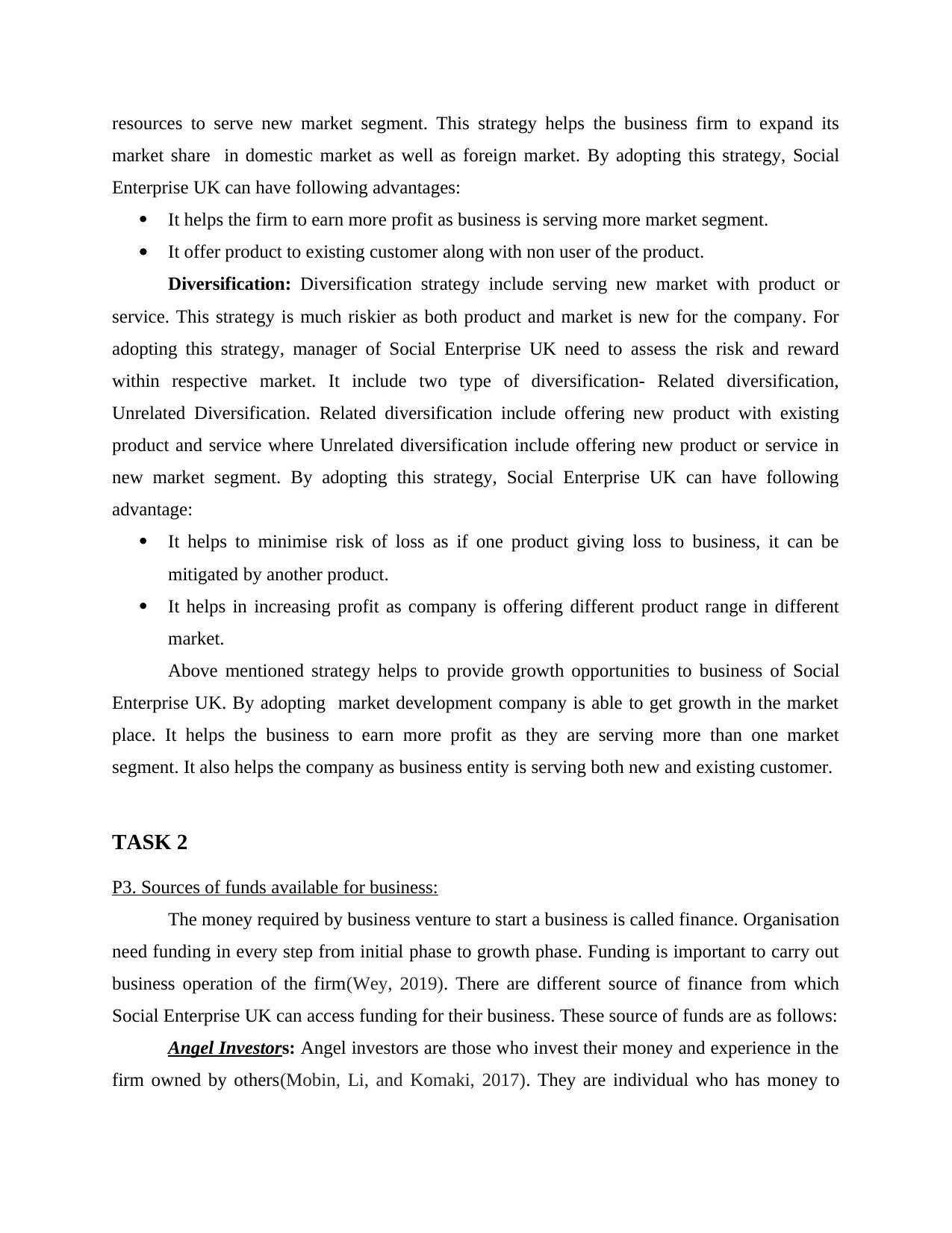
resources to serve new market segment. This strategy helps the business firm to expand its
market share in domestic market as well as foreign market. By adopting this strategy, Social
Enterprise UK can have following advantages:
It helps the firm to earn more profit as business is serving more market segment.
It offer product to existing customer along with non user of the product.
Diversification: Diversification strategy include serving new market with product or
service. This strategy is much riskier as both product and market is new for the company. For
adopting this strategy, manager of Social Enterprise UK need to assess the risk and reward
within respective market. It include two type of diversification- Related diversification,
Unrelated Diversification. Related diversification include offering new product with existing
product and service where Unrelated diversification include offering new product or service in
new market segment. By adopting this strategy, Social Enterprise UK can have following
advantage:
It helps to minimise risk of loss as if one product giving loss to business, it can be
mitigated by another product.
It helps in increasing profit as company is offering different product range in different
market.
Above mentioned strategy helps to provide growth opportunities to business of Social
Enterprise UK. By adopting market development company is able to get growth in the market
place. It helps the business to earn more profit as they are serving more than one market
segment. It also helps the company as business entity is serving both new and existing customer.
TASK 2
P3. Sources of funds available for business:
The money required by business venture to start a business is called finance. Organisation
need funding in every step from initial phase to growth phase. Funding is important to carry out
business operation of the firm(Wey, 2019). There are different source of finance from which
Social Enterprise UK can access funding for their business. These source of funds are as follows:
Angel Investors: Angel investors are those who invest their money and experience in the
firm owned by others(Mobin, Li, and Komaki, 2017). They are individual who has money to
market share in domestic market as well as foreign market. By adopting this strategy, Social
Enterprise UK can have following advantages:
It helps the firm to earn more profit as business is serving more market segment.
It offer product to existing customer along with non user of the product.
Diversification: Diversification strategy include serving new market with product or
service. This strategy is much riskier as both product and market is new for the company. For
adopting this strategy, manager of Social Enterprise UK need to assess the risk and reward
within respective market. It include two type of diversification- Related diversification,
Unrelated Diversification. Related diversification include offering new product with existing
product and service where Unrelated diversification include offering new product or service in
new market segment. By adopting this strategy, Social Enterprise UK can have following
advantage:
It helps to minimise risk of loss as if one product giving loss to business, it can be
mitigated by another product.
It helps in increasing profit as company is offering different product range in different
market.
Above mentioned strategy helps to provide growth opportunities to business of Social
Enterprise UK. By adopting market development company is able to get growth in the market
place. It helps the business to earn more profit as they are serving more than one market
segment. It also helps the company as business entity is serving both new and existing customer.
TASK 2
P3. Sources of funds available for business:
The money required by business venture to start a business is called finance. Organisation
need funding in every step from initial phase to growth phase. Funding is important to carry out
business operation of the firm(Wey, 2019). There are different source of finance from which
Social Enterprise UK can access funding for their business. These source of funds are as follows:
Angel Investors: Angel investors are those who invest their money and experience in the
firm owned by others(Mobin, Li, and Komaki, 2017). They are individual who has money to
Paraphrase This Document
Need a fresh take? Get an instant paraphrase of this document with our AI Paraphraser
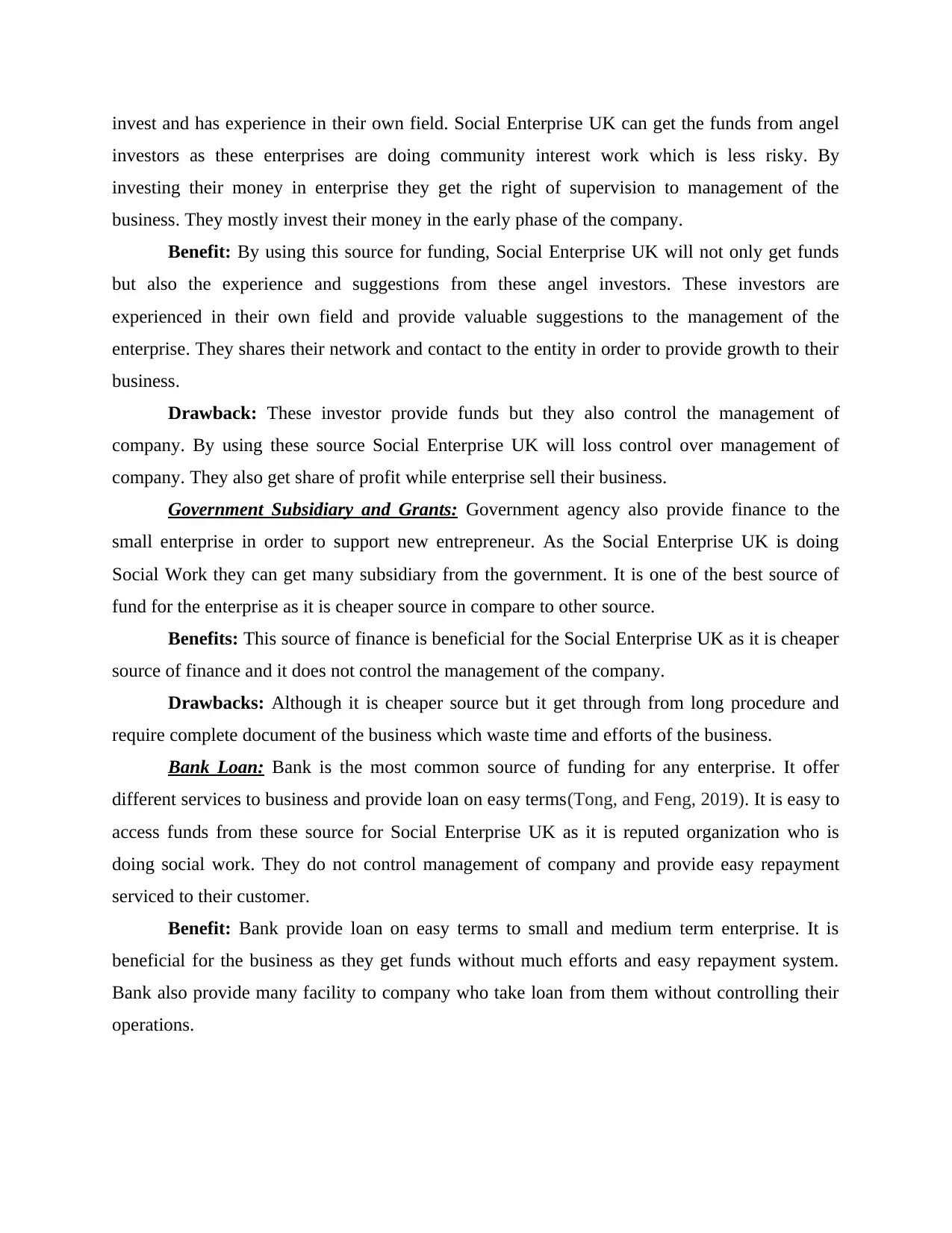
invest and has experience in their own field. Social Enterprise UK can get the funds from angel
investors as these enterprises are doing community interest work which is less risky. By
investing their money in enterprise they get the right of supervision to management of the
business. They mostly invest their money in the early phase of the company.
Benefit: By using this source for funding, Social Enterprise UK will not only get funds
but also the experience and suggestions from these angel investors. These investors are
experienced in their own field and provide valuable suggestions to the management of the
enterprise. They shares their network and contact to the entity in order to provide growth to their
business.
Drawback: These investor provide funds but they also control the management of
company. By using these source Social Enterprise UK will loss control over management of
company. They also get share of profit while enterprise sell their business.
Government Subsidiary and Grants: Government agency also provide finance to the
small enterprise in order to support new entrepreneur. As the Social Enterprise UK is doing
Social Work they can get many subsidiary from the government. It is one of the best source of
fund for the enterprise as it is cheaper source in compare to other source.
Benefits: This source of finance is beneficial for the Social Enterprise UK as it is cheaper
source of finance and it does not control the management of the company.
Drawbacks: Although it is cheaper source but it get through from long procedure and
require complete document of the business which waste time and efforts of the business.
Bank Loan: Bank is the most common source of funding for any enterprise. It offer
different services to business and provide loan on easy terms(Tong, and Feng, 2019). It is easy to
access funds from these source for Social Enterprise UK as it is reputed organization who is
doing social work. They do not control management of company and provide easy repayment
serviced to their customer.
Benefit: Bank provide loan on easy terms to small and medium term enterprise. It is
beneficial for the business as they get funds without much efforts and easy repayment system.
Bank also provide many facility to company who take loan from them without controlling their
operations.
investors as these enterprises are doing community interest work which is less risky. By
investing their money in enterprise they get the right of supervision to management of the
business. They mostly invest their money in the early phase of the company.
Benefit: By using this source for funding, Social Enterprise UK will not only get funds
but also the experience and suggestions from these angel investors. These investors are
experienced in their own field and provide valuable suggestions to the management of the
enterprise. They shares their network and contact to the entity in order to provide growth to their
business.
Drawback: These investor provide funds but they also control the management of
company. By using these source Social Enterprise UK will loss control over management of
company. They also get share of profit while enterprise sell their business.
Government Subsidiary and Grants: Government agency also provide finance to the
small enterprise in order to support new entrepreneur. As the Social Enterprise UK is doing
Social Work they can get many subsidiary from the government. It is one of the best source of
fund for the enterprise as it is cheaper source in compare to other source.
Benefits: This source of finance is beneficial for the Social Enterprise UK as it is cheaper
source of finance and it does not control the management of the company.
Drawbacks: Although it is cheaper source but it get through from long procedure and
require complete document of the business which waste time and efforts of the business.
Bank Loan: Bank is the most common source of funding for any enterprise. It offer
different services to business and provide loan on easy terms(Tong, and Feng, 2019). It is easy to
access funds from these source for Social Enterprise UK as it is reputed organization who is
doing social work. They do not control management of company and provide easy repayment
serviced to their customer.
Benefit: Bank provide loan on easy terms to small and medium term enterprise. It is
beneficial for the business as they get funds without much efforts and easy repayment system.
Bank also provide many facility to company who take loan from them without controlling their
operations.
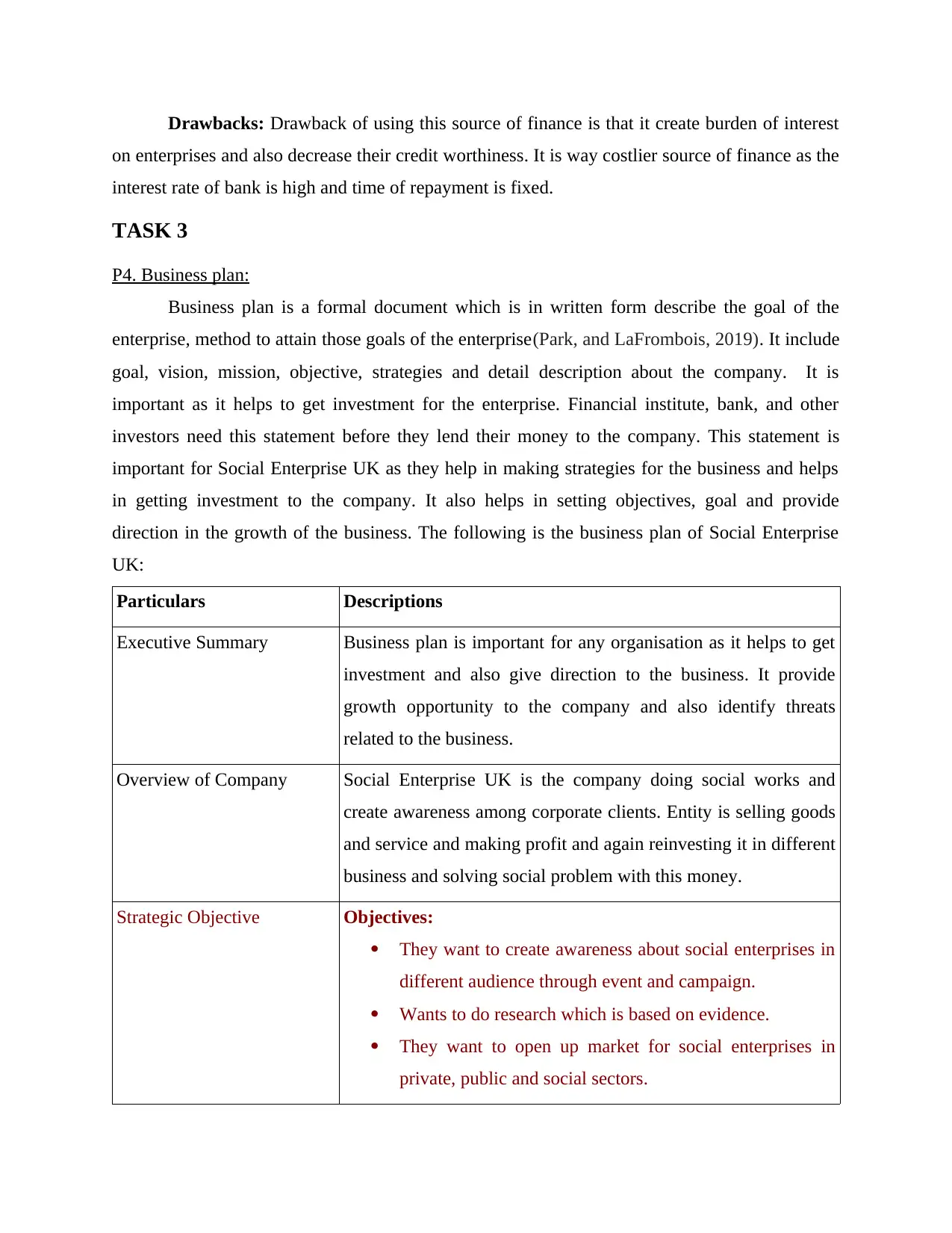
Drawbacks: Drawback of using this source of finance is that it create burden of interest
on enterprises and also decrease their credit worthiness. It is way costlier source of finance as the
interest rate of bank is high and time of repayment is fixed.
TASK 3
P4. Business plan:
Business plan is a formal document which is in written form describe the goal of the
enterprise, method to attain those goals of the enterprise(Park, and LaFrombois, 2019). It include
goal, vision, mission, objective, strategies and detail description about the company. It is
important as it helps to get investment for the enterprise. Financial institute, bank, and other
investors need this statement before they lend their money to the company. This statement is
important for Social Enterprise UK as they help in making strategies for the business and helps
in getting investment to the company. It also helps in setting objectives, goal and provide
direction in the growth of the business. The following is the business plan of Social Enterprise
UK:
Particulars Descriptions
Executive Summary Business plan is important for any organisation as it helps to get
investment and also give direction to the business. It provide
growth opportunity to the company and also identify threats
related to the business.
Overview of Company Social Enterprise UK is the company doing social works and
create awareness among corporate clients. Entity is selling goods
and service and making profit and again reinvesting it in different
business and solving social problem with this money.
Strategic Objective Objectives:
They want to create awareness about social enterprises in
different audience through event and campaign.
Wants to do research which is based on evidence.
They want to open up market for social enterprises in
private, public and social sectors.
on enterprises and also decrease their credit worthiness. It is way costlier source of finance as the
interest rate of bank is high and time of repayment is fixed.
TASK 3
P4. Business plan:
Business plan is a formal document which is in written form describe the goal of the
enterprise, method to attain those goals of the enterprise(Park, and LaFrombois, 2019). It include
goal, vision, mission, objective, strategies and detail description about the company. It is
important as it helps to get investment for the enterprise. Financial institute, bank, and other
investors need this statement before they lend their money to the company. This statement is
important for Social Enterprise UK as they help in making strategies for the business and helps
in getting investment to the company. It also helps in setting objectives, goal and provide
direction in the growth of the business. The following is the business plan of Social Enterprise
UK:
Particulars Descriptions
Executive Summary Business plan is important for any organisation as it helps to get
investment and also give direction to the business. It provide
growth opportunity to the company and also identify threats
related to the business.
Overview of Company Social Enterprise UK is the company doing social works and
create awareness among corporate clients. Entity is selling goods
and service and making profit and again reinvesting it in different
business and solving social problem with this money.
Strategic Objective Objectives:
They want to create awareness about social enterprises in
different audience through event and campaign.
Wants to do research which is based on evidence.
They want to open up market for social enterprises in
private, public and social sectors.
⊘ This is a preview!⊘
Do you want full access?
Subscribe today to unlock all pages.

Trusted by 1+ million students worldwide
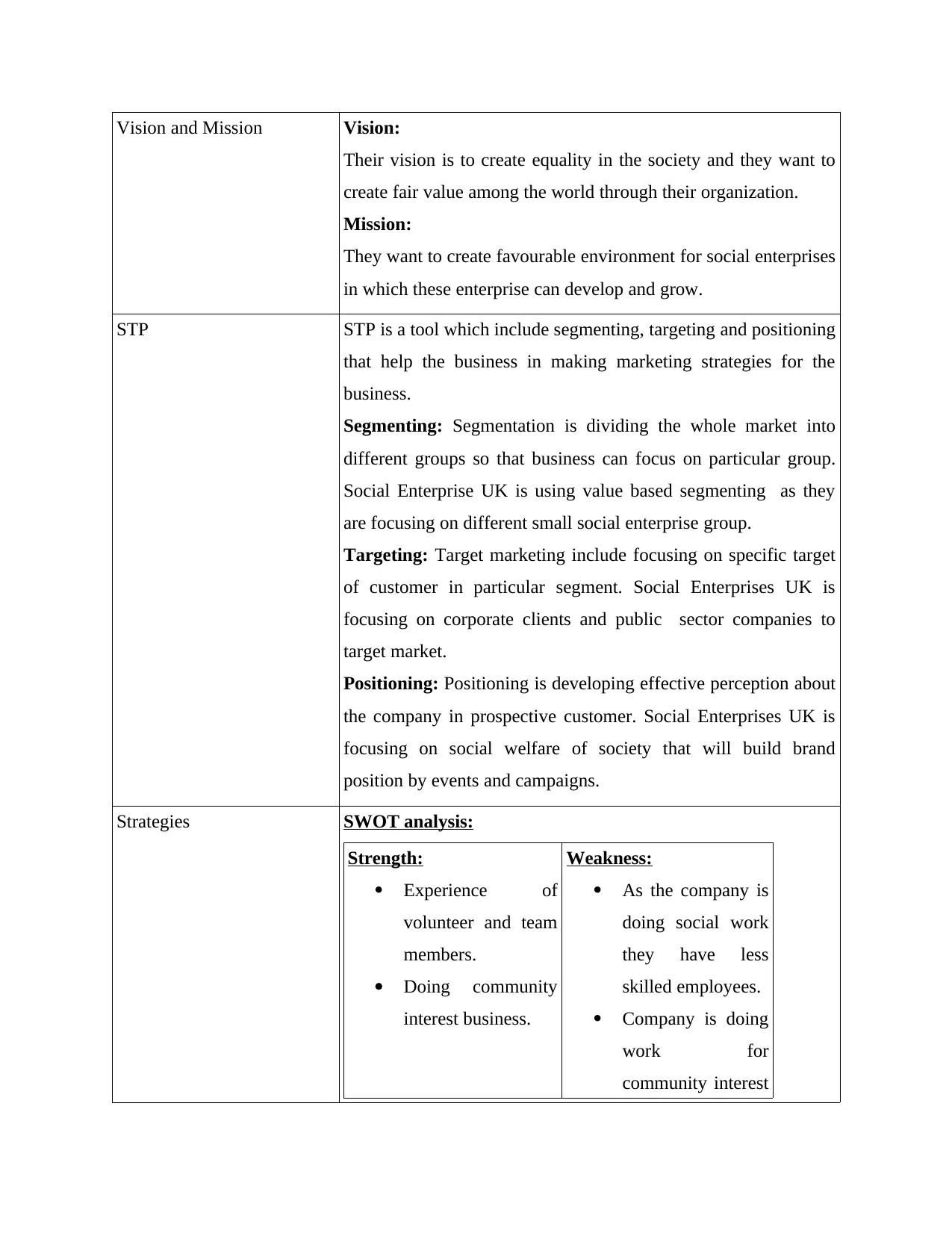
Vision and Mission Vision:
Their vision is to create equality in the society and they want to
create fair value among the world through their organization.
Mission:
They want to create favourable environment for social enterprises
in which these enterprise can develop and grow.
STP STP is a tool which include segmenting, targeting and positioning
that help the business in making marketing strategies for the
business.
Segmenting: Segmentation is dividing the whole market into
different groups so that business can focus on particular group.
Social Enterprise UK is using value based segmenting as they
are focusing on different small social enterprise group.
Targeting: Target marketing include focusing on specific target
of customer in particular segment. Social Enterprises UK is
focusing on corporate clients and public sector companies to
target market.
Positioning: Positioning is developing effective perception about
the company in prospective customer. Social Enterprises UK is
focusing on social welfare of society that will build brand
position by events and campaigns.
Strategies SWOT analysis:
Strength:
Experience of
volunteer and team
members.
Doing community
interest business.
Weakness:
As the company is
doing social work
they have less
skilled employees.
Company is doing
work for
community interest
Their vision is to create equality in the society and they want to
create fair value among the world through their organization.
Mission:
They want to create favourable environment for social enterprises
in which these enterprise can develop and grow.
STP STP is a tool which include segmenting, targeting and positioning
that help the business in making marketing strategies for the
business.
Segmenting: Segmentation is dividing the whole market into
different groups so that business can focus on particular group.
Social Enterprise UK is using value based segmenting as they
are focusing on different small social enterprise group.
Targeting: Target marketing include focusing on specific target
of customer in particular segment. Social Enterprises UK is
focusing on corporate clients and public sector companies to
target market.
Positioning: Positioning is developing effective perception about
the company in prospective customer. Social Enterprises UK is
focusing on social welfare of society that will build brand
position by events and campaigns.
Strategies SWOT analysis:
Strength:
Experience of
volunteer and team
members.
Doing community
interest business.
Weakness:
As the company is
doing social work
they have less
skilled employees.
Company is doing
work for
community interest
Paraphrase This Document
Need a fresh take? Get an instant paraphrase of this document with our AI Paraphraser

and they have less
profit.
Opportunity:
Support from
member of society.
Collaboration with
private sector
businesses
Threat:
Insecurity of
revenue funds.
Limited numbers
of employees
Marketing Mix:
Marketing mix is the combination of product, price, place and
promotion. It help the business to focus on essential activity of
the business. The components of marketing mix are as follows:
Product: It include the offering of an organization to
satisfy the needs and wants of their customer. Social
Enterprise UK is planning for expansion with a service
that is legal advice service.
Price: Price is the amount consumer is ready to pay for
the product or service. They are offering competitive
prices in open market.
Place: Place is the area company in which company is
serving goods and service. They are offering their goods
in UK and other countries.
Promotion: Promotion is the strategy business adopt to
communicate about their products to customers. They are
doing event and campaign to promote their business. For
promoting business manager of company is using email
marketing and print media.
Financial projection Budget
Particulars 31/12/20 31/12/21 31/12/22
profit.
Opportunity:
Support from
member of society.
Collaboration with
private sector
businesses
Threat:
Insecurity of
revenue funds.
Limited numbers
of employees
Marketing Mix:
Marketing mix is the combination of product, price, place and
promotion. It help the business to focus on essential activity of
the business. The components of marketing mix are as follows:
Product: It include the offering of an organization to
satisfy the needs and wants of their customer. Social
Enterprise UK is planning for expansion with a service
that is legal advice service.
Price: Price is the amount consumer is ready to pay for
the product or service. They are offering competitive
prices in open market.
Place: Place is the area company in which company is
serving goods and service. They are offering their goods
in UK and other countries.
Promotion: Promotion is the strategy business adopt to
communicate about their products to customers. They are
doing event and campaign to promote their business. For
promoting business manager of company is using email
marketing and print media.
Financial projection Budget
Particulars 31/12/20 31/12/21 31/12/22

Production Cost 4000 0 0
Promotion Cost 2000 1200 800
Advertising Cost 1000 800 1000
Technology Cost 1100 1000 1600
Total Cost 8100 3000 3400
Cash Flow Statement:
Particulars 1st Year 2nd Year 3rd Year
Initial Investment 9800 12560 18000
Borrowing 10500 6200 9500
Retained Earning 5500 8500 10000
Total 25800 27260 37500
Market Outlay
Promotion Expenses 8800 8000 13500
Distribution Expenses 4000 7400 9500
Publicity 5500 12500 8500
Total 18300 27900 31500
Evaluation and monitoring For evaluating business activity company is using KPI and
benchmarking techniques which are as follows:
KPI: It is a tool used to measure the performance and success of
the organization. It is stand for key performance indicator. The
manager of Social Enterprise UK can use KPI to accomplish the
objective of the business as it helps to understand the
performance of the business.
Benchmarking: It is a technique used to compare performance
and process of business with industry based on time, cost and
Promotion Cost 2000 1200 800
Advertising Cost 1000 800 1000
Technology Cost 1100 1000 1600
Total Cost 8100 3000 3400
Cash Flow Statement:
Particulars 1st Year 2nd Year 3rd Year
Initial Investment 9800 12560 18000
Borrowing 10500 6200 9500
Retained Earning 5500 8500 10000
Total 25800 27260 37500
Market Outlay
Promotion Expenses 8800 8000 13500
Distribution Expenses 4000 7400 9500
Publicity 5500 12500 8500
Total 18300 27900 31500
Evaluation and monitoring For evaluating business activity company is using KPI and
benchmarking techniques which are as follows:
KPI: It is a tool used to measure the performance and success of
the organization. It is stand for key performance indicator. The
manager of Social Enterprise UK can use KPI to accomplish the
objective of the business as it helps to understand the
performance of the business.
Benchmarking: It is a technique used to compare performance
and process of business with industry based on time, cost and
⊘ This is a preview!⊘
Do you want full access?
Subscribe today to unlock all pages.

Trusted by 1+ million students worldwide
1 out of 16
Related Documents
Your All-in-One AI-Powered Toolkit for Academic Success.
+13062052269
info@desklib.com
Available 24*7 on WhatsApp / Email
![[object Object]](/_next/static/media/star-bottom.7253800d.svg)
Unlock your academic potential
Copyright © 2020–2025 A2Z Services. All Rights Reserved. Developed and managed by ZUCOL.



